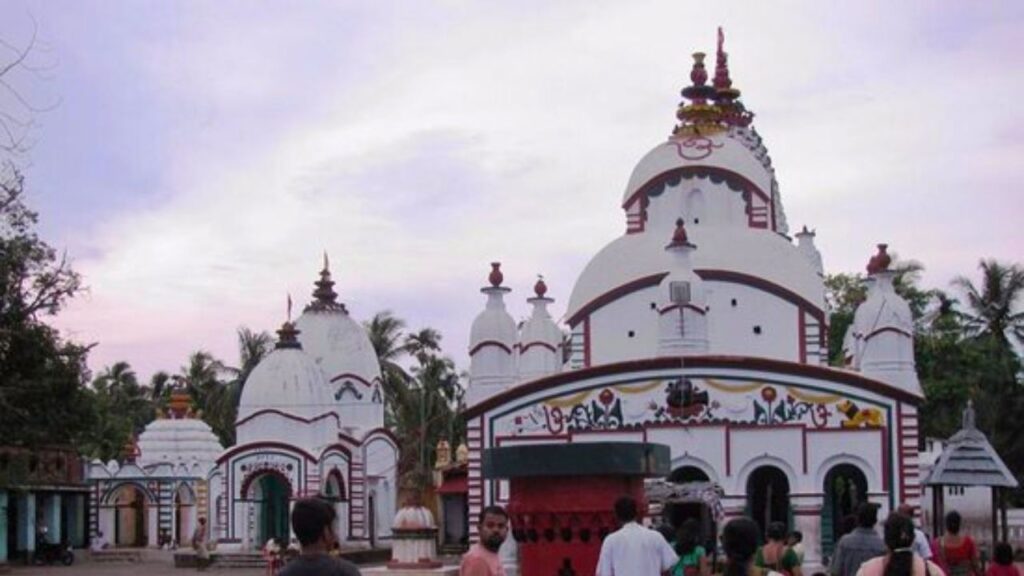Digha is famous for its beaches and (now) the new Jagannath temple, but this coastal resort town also has a quieter, spiritual side. A short drive or walk from the shore will bring you to several historic temples that glimpse Bengal’s rich devotional heritage. Below is a traveller-friendly guide to the top temples in and around Digha, other than the Jagannath Temple, with a bit of history, architecture notes, legends and practical tips for each.

Chandaneswar Temple – a white-domed Shiva shrine near Digha. Chandaneswar Temple (Lord Shiva) – Just south of Digha (about 8 km from New Digha), on the West Bengal–Odisha border, lies the ancient Chandaneswar Shiva Temple. This medieval temple is dedicated to Lord Shiva (“Nilkantha”) and was reportedly founded over a thousand years ago by King Mayuradhwaj of the Somavamshi dynasty. Its architecture is classic Odishan (Kalinga) style – white plastered walls with gentle curves and multiple spires (shikhara) – reminiscent of the great Sun Temple at Konark. Legend says the name “Chandaneswar” comes from chandana (sandalwood), which is used in worship. Inside, a large Shiva linga is worshipped daily, and you’ll often see pilgrims with offerings of Bilva leaves or pouring water. The temple is famously crowded during spring: the 13-day Chaitra Mela around mid-April (Pana Sankranti) and Maha Shivaratri draw hundreds of thousands of devotees. Outside festival time, the temple is much quieter – dawn or dusk visits let you enjoy the peaceful sea breeze and birdsong. Modern amenities (toilets, parking) were added recently, but the old-world charm remains.
- Location: Chandaneswar village (Odisha) on NH-16, ~8 km south of Digha’s New Beach.
- Best Time: Maha Shivaratri (Feb/Mar) or Chaitra Mela (Apr) for festivals; winter mornings or late afternoons for quieter visits.
- Accessibility: Take a taxi or local bus from Digha (approx. 20 min); there’s ample parking near the temple.
Bhagibaharampur Shiva Temple
A more modest Shiva Temple sits at the edge of Digha beach in Bhagibaharampur (also called Gadadharapur). This small temple has a simple white shrine and a single spire, with the sea visible just beyond. It’s popular with local fishermen and families: men often touch the Shiva linga before fishing, praying for calm seas. The atmosphere here is very relaxed – prayer bells and conch shells mingle with waves. The temple’s architecture is plain Bengali style (a square Garbhagriha with a smooth dome), but it feels very “Maritime Bengal” sitting by the casuarina groves. N’t grand legends are attached, but devotees say the temple’s Miramar puja (daily worship) brings good luck. Many visitors include it as a quick prayer stop in the early morning.
- Location: Bhagibaharampur village, on the western edge of Old Digha (near Udaipur Beach).
- Best Time: Early morning (for sunrise and prayer) or the evening aarti (around sunset). Special puja on Maha Shivaratri sees the busiest turnout.
- Accessibility: Within walking distance of Digha’s main beach road (or a short auto ride), there is a small courtyard and little parking.
Bhabar Harbola Mandir (Maa Harbola)
Hidden down a side street in Old Digha (near Mini Park) is the Bhabar Harbola Temple, a unique Shakti shrine. This temple honors Maa Harbola (Horbola), a fierce form of the Divine Mother, and was established in the 20th century by the Bengali mystic poet Bhabapagla. According to the guru’s tradition, his disciple Bhabar Gopal Bhai built this temple exactly as Bhabapagla envisioned. The idol of Mother Harbola is said to be beautiful and powerful, and the temple walls are painted with bright scenes of local folklore. The atmosphere feels like an ashram – there are notices about free charitable services and community feasts. Indeed, one of its most significant annual events is the “Bhabar Anandamela,” a springtime festival (usually late Feb–March) started on Bhabapagla’s centenary. The simple hall is decked with flower garlands and lively music during these 10 days of kirtans, Satsangs and free meals. On a typical day, the temple is calm: devotees quietly chanting mantras or reading bhajans in the pavilion.
- Location: Old Digha (Bhagibaharampur area), a short walk south from the Mini Park.
- Best Time: Falgun (late Feb–Mar) during the annual Anandamela fair. Otherwise, early mornings or evenings for daily arati.
- Accessibility: Easily reached on foot or by cycle-rickshaw from Old Digha bazaar. The ashram is small, with modest facilities (no ample parking).
Nehru Bazar Kali Mandir
Another of Digha’s oldest temples is the Kali Mandir at Nehru Bazaar (Old Digha market). This white-painted temple stands just south of the busy market street. Its façade even has the words “Kali Mata Mandir” in red letters above the arch. Inside, a marble statue of Dakshina Kali (tamed face, sword and shield) presides under twinkling lights. The temple exudes a “soul-soothing” calm despite the hustle of the nearby bazaar. Locals claim this shrine has been here for many decades and is the focal point for Diwali-Kali Puja festivities. On Kali Puja night (Oct/Nov) and Diwali evening, hundreds of devotees fill the courtyard with oil lamps, incense and chants. Even on an ordinary day, the temple’s weekday schedule (open roughly 9–12 & 5–9) welcomes morning and evening prayers. Outside peak hours, the shrine is remarkably peaceful – a few elderly worshippers might be sitting and offering khichuri or sweets to the goddess.
- Location: Old Digha (south end of Nehru Market, near the bus stand).
- Best Time: Kali Puja/Diwali (Oct–Nov) evenings are magical here. For less crowd, visit at dawn or dusk on any day.
- Accessibility: Right by the main road, with small street parking available. Convenient if you’re also visiting nearby shops or the beach.
ISKCON Sri Sri Radha Madhav Mandir (Krishna)
On the far side of Digha, a vibrant ISKCON temple dedicated to Sri Sri Radha Madhav (Radha–Krishna) was recently built in Jatimati village (on the bypass road). This Hare Krishna shrine features idols of Radha and Krishna under a richly decorated altar. The exterior gateway is painted in gold and blue motifs, giving a festive feel. Inside, you’ll hear bhajans and kirtans daily – the faithful gather for Mangala- aartis at dawn and dusk. ISKCON-run temples are known for community meals, and devotees can often sample free sweets or khichdi after the aarti. Special festivals draw big crowds: Janmashtami (Krishna’s birthday in August) and the Ratha Yatra (chariot festival in summer) see colorful processions with dancing and drumming. Architecturally, it’s pretty different from the ancient temples – the domes and mandapa have a modern, North-Indian temple look.
- Location: Jatimati village on the Digha Bypass (NH-116B), ~3 km east of New Digha.
- Best Time: Janmashtami (Aug) for celebrations. Or visit any morning/early evening when the temple is peaceful.
- Accessibility: Well-marked from Digha. Plenty of parking, reachable by auto/taxi or a short bike ride from town.
Each of these temples adds a special flavour to a Digha trip. Whether you’re a devout pilgrim or a curious traveller, they offer art, legend and a glimpse of local life beyond the beach.
Happy travels (and Om Namah Shivaya).
Sources: Historical and cultural details are drawn from local travel guides and temple records.
You may read this: The Story Behind Digha’s Jagannath Temple: A New Landmark with a Rich Legacy

